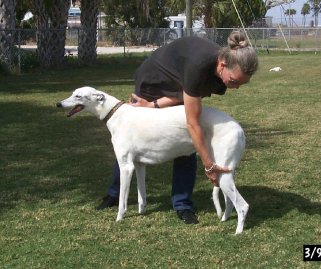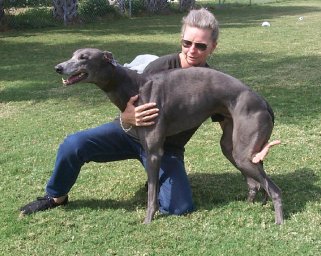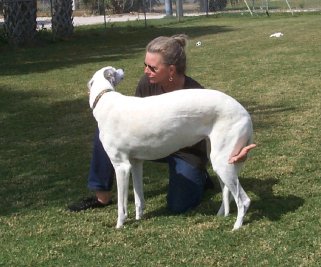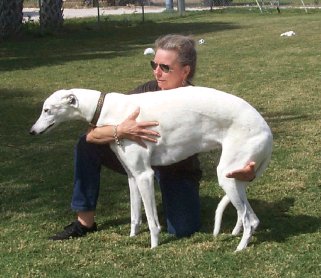Philosophy: Home training or companion training a Greyhound should be a mission of love and passion. It should be an exploration of his body and soul while reassuring him yours can be his for the asking.
You are not teaching him anything he does not already know. What you are doing is coming together for the purpose of acting in unison. Your adventures in connecting a human word to a canine behavior should be a mutual learning experience. If you think you are smarter than he is or that you are here to teach him something, you are reading the wrong article.
The sit is not an unnatural position for a Greyhound. He has never been taught not to sit (contrary to urban myth). It does not hurt when he sits (unless he has an injury). If you walk into a racing kennel you will see dogs sitting in their crates. Visit a Greyhound farm that has pallets and you will see a Greyhound back up to and sit on the edge of his. Greyhounds can be found sitting on steps, motorhome engine boxes and between your knees in any lawn chair you are already occupying.
A Greyhound does not sit, most of the time, because he sees no need to make one half of his body useless. (Or as one sage put it, "If it can't be done laying down or standing up, it probably ain't worth doing.") In the prone or sphinx position, a Greyhound can rise and be in full stride with one motion. No need to operate front and rear landing gear independently.
Just because it doesn't look comfortable to you is irrelevant. Look at the way they sleep, with their arms over their heads, hanging in mid air. Look at some of the places they choose to sleep. I have one who insists on wedging herself between the pillow and the headboard, even if it means she will get slept on.
If a dog will stand still, why would anyone want him to sit anyway? Most people who repeatedly yell, "sitsitsitsitsit" really just want the dog to stop what he is doing. True, if he is sitting, he can't be jumping on people, but why not just teach him not to jump on people? Why teach the sit at all?
For the love and passion of it. For the communication and the bonding of it. Is it going to be fun? I don't know; it's kind of like sex: You can do it for love or you can do it for fun. What we are not going to do, is do it for food.
Food is what every dog should get, like air and water. You are not training a porpoise, whale or manatee. You are training a Greyhound. If you train him with food, that is exactly what he is going to see you as: a food dispenser. If you want him to love you, train him with love. Isn't his constant need for our affection and approval what endears us to this breed over others? Use his intelligence, his desire to please, his need for love and physical contact, to show him what you want.
First of all, make sure he has no injuries. This includes running your fingers down each side of his spine from shoulders to tail. If he winces or his skin appears to twitch, go see your canine health care provider. Second, get an anatomy book and look up where the stifle joint is located. What we want is the area in back of the stifle, just below those beautiful buns of steel


Begin by getting down on one knee, whichever one bends the best if you are over 45. Place your left arm around his chest, but very low, like even with his elbow. We do not wish to put any pressure on his trachea or throat area. You are holding him against your chest so he will feel secure.
The only part of your right arm to use is the wrist-to-elbow. This is placed behind the stifle joint, where the two bundles of muscles meet

You are folding, not tucking, him. Pretend he is an accordion. You must move both ends at the same pressure and speed: slowly, gently and relentlessly

You do not want him to learn to tuck his tail under him for aesthetic purposes. Besides, not all tails bend equally. If the tail gets caught under the hock, yes, that could be painful. Tails that have been injured and do not bend under will be uncomfortable. Curly tails are unpleasant to sit on.
If he sits on your arm, you will be trapped underneath him. His weight will pull you over, he will collapse on top of you and you will start laughing. He will get the idea that is what turns you on and refuse to get up.

He should be allowed to get up of his own accord anytime he feels anxious. No one is forcing anyone. Let's do it again. Pretty soon you will get the feeling of just where to place your arms, just how to hum gentle reassurance. Once he begins to relax his muscles, you will learn how to up the tempo and pitch of your voice as if you are cheering him to a touchdown. Literally speaking, you are.
Break your training sessions up. If he does not have trust in you, he will begin to resist. It is time to quickly do something else, like bounce a ball, run a couple of feet, while making funny noises or toss and squeak his favorite toy. What you want to accomplish is the immediate dissipation of any negative feelings he might have built up from not understanding what you were doing. Don't worry, do it enough times and he won't care anyway. Let him concentrate on your arms around him, your voice patterns, your praise.
Your goal, the first day is to get him to allow you to rock him slightly backwards with one arm, while putting gentle pressure against the muscle bundles with your forearm. Don't forget to sweep the tail straight out behind.
Without holding him in place, he should comfortably and confidently rest his body against yours for as long as you keep up the stoking and singing of paeans. This will depend on how many times you perform the accordion exercise and how gushy and grateful your appreciation is expressed.
Remember your goal is getting him to trust you. You cannot do this if you do not 'know' him. Observe him! What sounds do you make that please him? Try modulating your voice. Chirp. Giggle. Does he have an itchy spot? You are home free! Itchy dogs will train in a heartbeat. Know his body, know his mind.
This will determine the timing of the next step. When you grunt and groan your aging body into the kneeling position, place your arms in the hug position, and he promptly sits on your arm, that is step one. You have not ever used the word "Sit." You have never indicated you wanted anything other than to hold his body close to yours and whisper, squeak, squeal, cheer and/or hum him your adoration.
When you are successful, try this while you are standing. You still have to bend over to hug and kiss on him, make no mistake. Do what he likes, say what he wants to hear, if you are lucky, just scratch his itch. Go back a step any time you have tried to rush him.
Is it time to change positions? Spread your right hand across his chest with some fingers reaching between his front legs. With the palm of your left hand, apply pressure against the back of the stifle joint closest to you. If he slowly lowers himself into a sit, sing him an opera. Warble, chirp, cheer, squeak and giggle. Keep your hands roaming over his gorgeous physique. Massage, rub, stroke. Cease when he gets up or you get tired, whatever comes first.
Yes, this is repetitious, but if you aren't learning things about him, you aren't doing it right. If he isn't becoming more physically malleable, you aren't pushing his love buttons.
If you are getting it right, it is time to change again. Finally, it is time to say the magic word. Say, don't yell, "Sit." Pause while you get what you asked for and don't forget to tell him he's the greytest! Don't forget the exclamation point. You are going to move your right hand to his collar now, pulling gently back, not up. The fingers of your left hand will put a slight upward pressure on that area behind the stifle. Say "Sit" and start singing. There should never be enough pressure on his collar for him to cough or wheeze.
When you have this down, keep your right hand on the collar, but start moving your left hand up his leg, a little at a time. Compliance with any of the steps is trust and understanding. Non-compliance means you are not doing something right. Yes, failure is always your fault.
Once you are at the top of his leg, you can put your left hand between his hips and tail, while exerting a mild downward and tucking pressure. Keep your mouth in gear!! Any time he takes the pressure on his collar, which should be running parallel with his back, to mean back up, slide your hand back to his hindquarters to indicate that end stays still.
Soon a finger under the collar, a hand above his tail and a single word, "Sit", will be all it takes. Do not forget the hugs and praise. It is now only a matter of time before a finger under the collar and finger on his rump, with one syllable of "Sit" will do.
Warning: Use of this method may increase his need for body contact with you. It may induce affection-seeking behavior and a need to sit in your lap.
All photos and Greyhounds, compliments of Sarah and Ed Jones. Belle is the white female; Bo is the blue mal